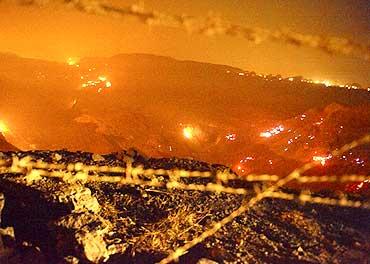
The haunting inscription that marks the gates of hell in Dante's Inferno could well be true for Jharkhand. For, the underground fires that have been raging in the coalfields of this state over several years are now beginning to engulf its thickly inhabited areas as well.
An underground mine fire that has been raging for nearly six months now poses a threat to railway tracks after it led to the closure of the Ranchi-Patna National Highway last year.
The mine fire spotted at four to five places near the Kalyani project of Central Coalfield Limited at Bermo in Bokaro district has posed a threat to both the Bermo-Chandrapura-Dhanbad highway and the Gomoh-Barkakana railway route. The railway track is around 40 feet away from the fire and the highway is around 10 feet away. The fire is spread out in a two-kilometre area.
Earlier, the National Highway-33, which connects Ranchi and Patna via Hazaribagh and Koderma, was closed August 7, 2009 because of the underground mine fire that touched the road.
Meanwhile, another underground mine fire now poses a threat to railway tracks at Bansjora, a railway halt in Dhanbad district. It falls between Dhanbad and Katras railway route used daily by the Rajdhani and Shatabdi Express trains.
The fire broke out at quarry No. 15 of Godhra coal mine in 2008 and spread fast almost two kilometers from the Godhra railway station near Dhanbad town forcing 400 families to be evacuated from near the open-cast mine belonging to Bharat Coking Coal Limited.
Residents said they saw flames as high as 15 feet, forcing them to flee onto the highway where traffic had to be stalled for nearly an hour.
Panic gripped Sudamdih new mines area under eastern Jharia on December 28, 2007 when large cracks developed on the road and buildings spread over an area of nearly half km due to the land subsidence. While major cracks developed in almost all the rooms of Birsa Memorial High School, minor cracks were seen on walls of many houses of mini slum area situated by the side.
According to eyewitness, the residents of the locality heard some gurgling sound from beneath the earth at around 9.30 in the morning and cracks started developing on the surface. Fearing major land subsidence, residents came out of their houses and started running helter-skelter.
In October 2007, the area had experienced gas leakage from beneath the earth after which the coal organisation management dug many holes to control the underground fire by stowing water mixed with sand through the holes. It is all due to underground mine fire which is now slowly engulfing the area.
Such is the intensity of the fires that even a mid-summer sun pales in the smoky haze that they generate. After dusk, the flames take on morbid hues. "Jharia resembles a cremation ground at night".
Few years ago the town's temple snapped into two. The next moment, flames leapt out from underneath spewing noxious gases. The people of Jharia then realised that the underground fire had finally reached their doorstep.
Some 150,000 miners, truck drivers, loaders and other workers brave this hazard to eke out a living. The fires have consumed about 42 million tonnes of India's best coking coal.
There appears to be no permanent solution in sight. The only opinion seems to be cut out trenches to disconnect fire seams which have been identified. But this would require a huge investment. But the extent to which has flared up in Jharia makes dousing it an uphill task-particularly when all the prevailing conditions further fan the fire.
The only solution which is now seen is the shifting of the town. This means that the relocation would affect the nearly 3 lakh population of Jharia, approximately 1 lakh houses and other buildings and a prospering economy.
No comments:
Post a Comment